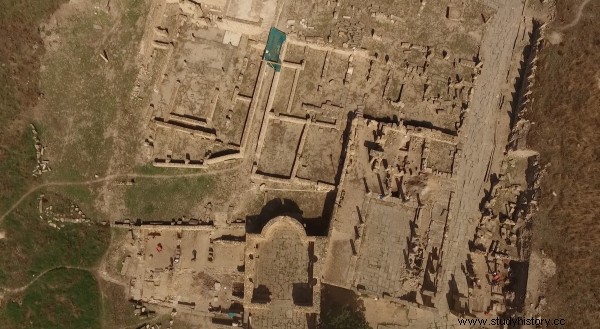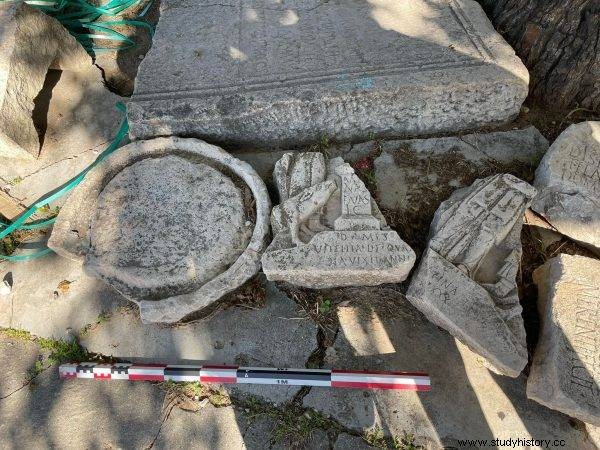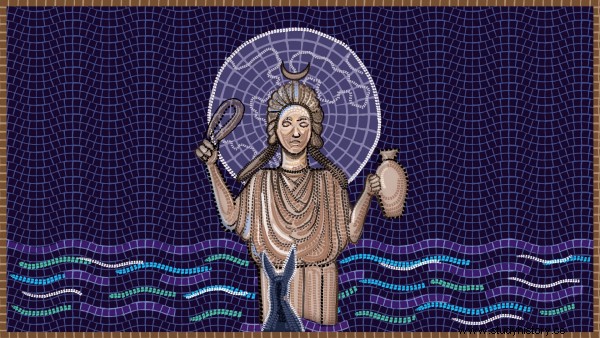Although ancient civilizations still keep many secrets from us, our knowledge of the past grows significantly each year.
It is possible thanks to the hard work of scientists representing various fields of knowledge. Research on antiquity at the University of Warsaw is carried out by researchers and researchers of various units and specialties, focused in particular on history, classical philology, archeology, oriental studies, ancient law and philosophy. The Center for Research on Ancient Civilizations (CRAC) was established to support the activities of this environment and to disseminate the results of its representatives' research. These are some of the pioneering antiquity research conducted at the University of Warsaw.

Mustis ruins. Photo from the drone by Jakub Świda.
A family portrait with a hog
For years, Tunisia has been popular among Polish tourists. Travel agencies tempt customers with rest in luxurious resorts, seasoned with a bit of local exoticism:trips to the desert, camel ride or a visit to the Arab market. On the other hand, connoisseurs will find Islamic, Roman and Carthaginian monuments. However, it is in vain to look for a mention of the Mustis ruins in tourist catalogs. Perhaps it will change soon thanks to the work of Polish archaeologists under the supervision of prof. Tomasz Waliszewski. This city, 120 km from Carthage, has not been explored very intensively so far. The modest archaeological park allowed you to see the few exposed remains of buildings dating mainly from the times of the Roman Empire. The work carried out during the first excavation seasons has already made it possible to change the view on the history of the city. The Romans took the territory of today's Tunisia after the final defeat of Carthage in 146 BCE, and they found themselves in Mustis in 102 BCE. At that time, veterans from the army of the republican commander Mariusz were settled here. The polls showed, however, that they did not settle in uninhabited land.
It turned out that previously there was a settlement in this place, which may have existed already in the 5th century BCE. In addition, thanks to non-invasive research, we know that the visible remains are only a modest part of this center, which in times of prosperity must have covered an area of approx. 30 ha. It therefore proves that it was an older and more important center than previously assumed. This allowed us to establish ambitious plans for the next seasons. The object of particular interest will be learning about the earliest history of the settlement. Since it already existed in Carthaginian times, archaeologists will try to look at the cultural changes taking place at the meeting point of three cultures:the local Numidian population (the ancestors of today's Berbers), the Carthaginians who came to Africa from Phenicia, and the Romans.

Fragment of a tombstone depicting a pig. The photo was taken by Tomasz Waliszewski.
Initial research also whets the appetite for future discoveries. At the moment, archaeologists have located three working temples, and thanks to the analysis of the preserved inscriptions, we know that at least ten of them were in operation in Mustis. Collaboration of researchers with different specializations has already produced some interesting results. It turned out that along with the Roman colonists, Mustis also found ... pigs. They were not bred by the Phoenicians, and also later disappear with the spread of Islam. Meanwhile, for the Roman population of Mustis, pigs became a status symbol, a sign of family wealth. The farms had to be so profitable that on some tombstones the deceased spouses were portrayed with pigs so that those passing by the grave would know that wealthy people were placed in it.
How did ancient monks deal with procrastination?
Prof. Ewa Wipszycka.
Donkey from the land of witches
Thessaly was different from other parts of mainland Greece. As a lowland region, it offered quite good conditions for farming, as well as the possibility of breeding horses on a scale unattainable for other Greeks. The Thessaly were famous for their large and great cavalry. They took part in the battles fought by the Athenian tyrants (in the 6th century BCE) and were an important part of the army of Philip of Macedon and his son Alexander. The tessks had a worse opinion. It seems that the fascinating otherness of Thessaly contributed to the belief that it is a suspicious land of magic and witches. Thessalian women were to be masters of the use of poisons and sinister powers. They have been credited with reviving the dead they have temporarily brought back to life in order to learn about the future from them, and even believed that they had such great power that they could draw the moon down from the sky.

Illustration for the Metamorphoses of Apuleius of Madaura. Made by Marta Maszkiewicz.
No wonder that such an exotic land fascinated ancient authors. One of the most frequently reproduced and processed was the story of the adventures of Lucius, who, having entered into an affair with the witch's maidservant, asked her to steal her mistress's ointment that allowed him to turn into a bird. However, through a series of unfortunate circumstances, he was transformed into a donkey, and then wandered in this form, going through various adventures before becoming a human again.
Among the works devoted to his adventures, the longest and most refined is the Latin work Metamorphoses or the golden donkey by Apuleius of Madaura, a Roman rhetorician and philosopher from the 2nd century AD Unlike the rather entertaining Greek works, Apuleius weaves in his work a religious message related to initiation into the cult of the goddess Isis, popular during the Roman Empire. Dr. Julia Doroszewska (Faculty of History, University of Warsaw) examined how in this novel the author used various transitional and borderline places to reflect the changes taking place in the hero. From a debauched young man turns into a donkey, and later, having regained his human form, becomes an ascetic and spiritual priest of the goddess Isis. How did this come about? Those interested in Lucius' transformations can learn more about our material about the novel Golden Donkey.
How did the bureaucracy arise in Babylon?
Dr. hab. Małgorzata Sandowicz.
We encourage you to watch a series of popular science films devoted to some of the pioneering research on antiquity conducted at the University of Warsaw.
Center for Research on Ancient Civilizations on Facebook:
https://www.facebook.com/UW.CRAC
https://crac.uw.edu.pl/pl/popularyzacja-nauki/
YouTube channel of the Faculty of History of the University of Warsaw.
The promotional material was prepared by Roman Żuchowicz, MA, as part of the project "Various paths to the past", financed by the Initiative of Excellence of the University of Warsaw Research. 
